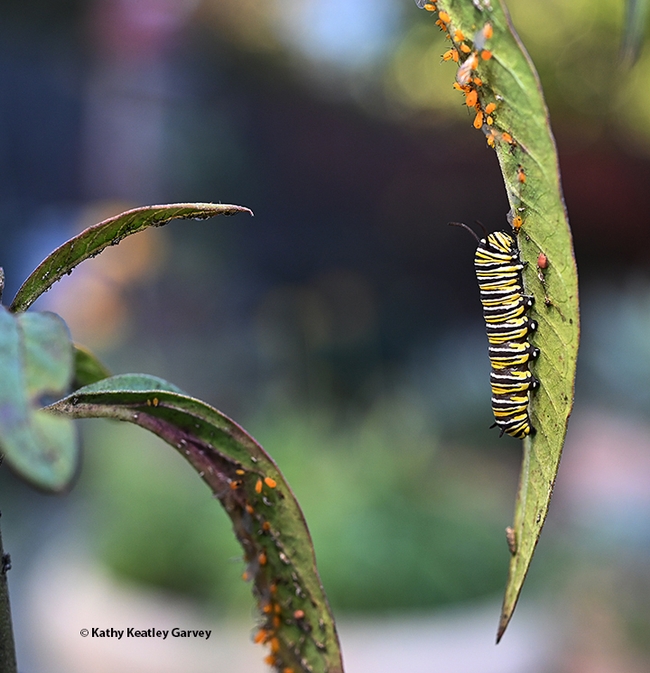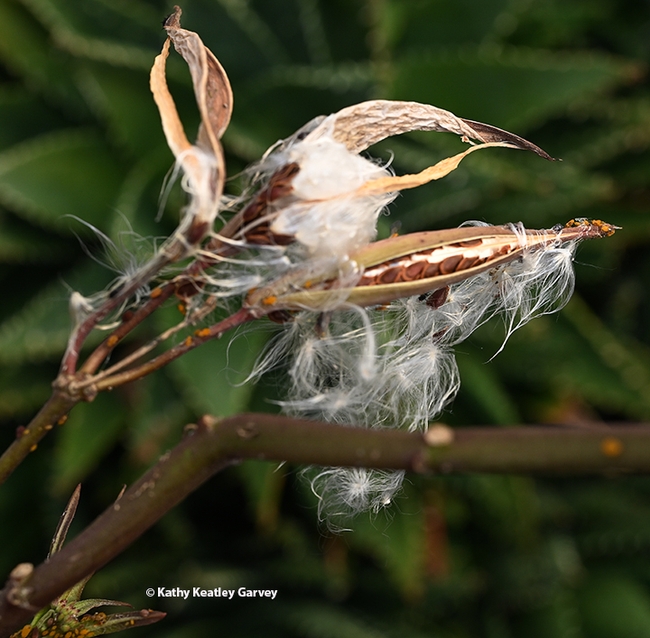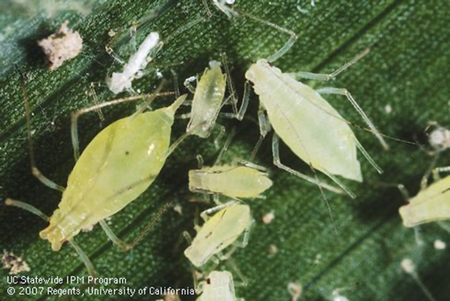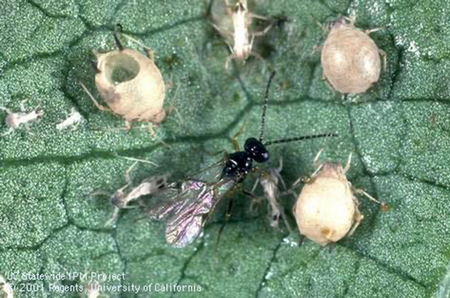Posts Tagged: aphids
Lawn-pocalypse! Surviving Drought
Ah, summer! The season of sunburns, pool parties, and… lawn droughts. If your once lush, green carpet now looks like a crunchy brown doormat, you're not alone. Let's dive into why your yard is staging a dramatic death scene and what you can do to...

Bermuda grass and weeds overtaking drought stressed turf grass.
Why Soldier Beetles Deserve the Aphid Belt
It's the Fourth of July and what better time to post images of the aptly name "soldier beetles" than today. These insects (family Cantharidae) resemble the uniforms of the British soldiers of the American Revolution, which is apparently how their name...

It's early morning, and a soldier beetle stirs in a Vacaville garden. A beneficial insect, it eats aphids and other soft-bodied insects. (Photo by Kathy Keatley Garvey)

Are the Red Coats coming? No, but this soldier beetle is alert. (Photo by Kathy Keatley Garvey)
Monarch 'Cats Sleeping with the Aphids
Sleeping with the aphids...that's what this monarch caterpillar was doing. It lived--and quite hidden at that--through the freezing cold, the rain, and the wind. It surfaced today on a milkweed in our Vacaville pollinator garden. Surprise,...

A monarch caterpillar sharing a milkweed leaf with oleander aphids on Dec. 8, 2023 in a Vacaville garden. (Photo by Kathy Keatley Garvey)

Milkweed going to seed on Dec. 8, 2023 in a Vacaville garden. (Photo by Kathy Keatley Garvey)
Climate-Change Resources
University of California UC ANR Green Blog (Climate Change and Other Topics) https://ucanr.edu/blogs/Green/index.cfm?tagname=climate%20change (full index)
Examples:
- Save Trees First: Tips to Keep Them Alive Under Drought https://ucanr.edu/b/~CdD
- Landscaping with Fire Exposure in Mind: https://ucanr.edu/b/~G4D
- Cities in California Inland Areas Must Make Street Tree Changes to adapt to Future Climate https://ucanr.edu/b/~oF7
Drought, Climate Change and California Water Management Ted Grantham, UC Cooperative Extension specialist (23 minutes) https://youtu.be/dlimj75Wn9Q
Climate Variability and Change: Trends and Impacts on CA Agriculture Tapan Pathak, UC Cooperative Extension specialist (24 minutes) https://youtu.be/bIHI0yqqQJc
California Institute for Water Resources (links to blogs, talks, podcasts, water experts, etc.) https://ciwr.ucanr.edu/California_Drought_Expertise/
UC ANR Wildfire Resources (publications, videos, etc.) https://ucanr.edu/News/For_the_media/Press_kits/Wildfire/ (main website)
-UC ANR Fire Resources and Information https://ucanr.edu/sites/fire/ (main website)
-Preparing Home Landscaping https://ucanr.edu/sites/fire/Prepare/Landscaping/
UC ANR Free Publications https://anrcatalog.ucanr.edu/ (main website)
- Benefits of Plants to Humans and Urban Ecosystems: https://anrcatalog.ucanr.edu/pdf/8726.pdf
-Keeping Plants Alive Under Drought and Water Restrictions (English version) https://anrcatalog.ucanr.edu/pdf/8553.pdf
(Spanish version) https://anrcatalog.ucanr.edu/pdf/8628.pdf
- Use of Graywater in Urban Landscapes https://anrcatalog.ucanr.edu/pdf/8536.pdf
- Sustainable Landscaping in California https://anrcatalog.ucanr.edu/pdf/8504.pdf
Other (Non-UC) Climate Change Resources
Urban Forests and Climate Change. Urban forests play an important role in climate change mitigation and adaptation. Active stewardship of a community's forestry assets can strengthen local resilience to climate change while creating more sustainable and desirable places to live. https://www.fs.usda.gov/ccrc/topics/urban-forests
Examining the Viability of Planting Trees to Mitigate Climate Change (plausible at the forest level) https://climate.nasa.gov/news/2927/examining-the-viability-of-planting-trees-to-help-mitigate-climate-change/
Reports and other information resources coordinated under the auspices of the United Nations and produced through the collaboration of thousands of international scientists to provide a clear and up to date view of the current state of scientific knowledge relevant to climate change. United Nations Climate Action
Scientific reports, programs, action movements and events related to climate change. National Center for Atmospheric Research (National Science Foundation)
Find useful reports, program information and other documents resulting from federally funded research and development into the behavior of the atmosphere and related physical, biological and social systems. Search and find climate data from prehistory through to an hour ago in the world's largest climate data archive. (Formerly the "Climatic Data Center") National Centers for Environmental Information (NOAA)
Think tank providing information, analysis, policy and solution development for addressing climate change and energy issues (formerly known as the: "Pew Center on Global Climate Change"). Center for Climate & Energy Solutions (C2ES)
Mapping Resilience: A Blueprint for Thriving in the Face of Climate Disaster. The Climate Adaptation Knowledge Exchange (CAKE) was launched in July 2010 and is managed by EcoAdapt, a non-profit with a singular mission: to create a robust future in the face of climate change by bringing together diverse players to reshape planning and management in response to rapid climate change. https://www.cakex.org/documents/mapping-resilience-blueprint-thriving-face-climate-disaster
Cal-Adapt provides a way to explore peer-reviewed data that portrays how climate change might affect California at the state and local level. We make this data available through downloads, visualizations, and the Cal-Adapt API for your research, outreach, and adaptation planning needs. Cal-Adapt is a collaboration between state agency funding programs, university and private sector researchers https://cal-adapt.org/
Find reports, maps, data and other resources produced through a confederation of the research arms of 13 Federal departments and agencies that carry out research and develop and maintain capabilities that support the Nation's response to global change. Global Change (U.S. Global Change Research Program)
The Pacific Institute is a global water think tank that combines science-based thought leadership with active outreach to influence local, national, and international efforts to develop sustainable water policies. https://pacinst.org/our-approach/
Making equity real in climate adaptation and community resilience policies and programs: a guidebook. https://greenlining.org/publications/2019/making-equity-real-in-climate-adaption-and-community-resilience-policies-and-programs-a-guidebook/
Quarterly CA Climate Updates and CA Drought Monitor Maps (updated each Thursday) https://www.drought.gov/documents/quarterly-climate-impacts-and-outlook-western-region-june-2022
Aphids in the Garden
Aphids can be a scourge in the garden. There are over 4,000 species of aphids in the world, but fortunately only(!) about 250 species are attracted to the plants we grow in our gardens and landscapes.
Aphids are small, slow-moving insects that come in a variety of colors—green, yellow, brown, red, or black. They sometimes match the color of the plant they feed on, but not always. They have long legs and antennae, and usually have a pair of cornicles (tube-like structures) sticking out of their hind end. No other insects have cornicles. Some adult aphids have wings—this can occur when populations are high or during spring and fall—that can allow them to disperse to other plants.
Aphid reproduction is interesting. Adult females can give birth to up to 12 live offspring each day without mating. During warm weather, many aphid species can grow from newborn nymph to reproductive adult in a week. No wonder it seems like they appear overnight.
Aphids are attracted to plants on which they can feed. Plants that are actively growing are prime targets. Right now, these include plants in our winter gardens such as kale and broccoli and landscape plants such as roses, but also the many winter weeds growing abundantly in many neighborhoods.
Aphids have sucking mouth parts, somewhat like little straws. They use them to suck sap (which is a plant's sugar source). What they excrete is commonly referred to as ‘honeydew' which contains sugar and is therefore sticky. Ants are attracted to this honeydew and will actively “farm” the aphids and protect them against natural predators.
Many plants, especially trees and shrubs, can survive just fine with low to moderate numbers of leaf-feeding aphids. Damage can occur with larger populations. Yellowing leaves and stunted growth are common.
Aphids can also transmit viruses from plant to plant on many vegetable crops and ornamental plants. Symptoms can include mottled, yellow, or curled leaves, along with stunted growth.
Controlling aphids
Understanding their life cycle is key to their management. By checking plants twice a week while they are growing rapidly, you can catch infestations early. With small populations of wingless aphids, hosing them off with a strong stream of water works well. Once off the plants, aphids are unlikely to be able to return. You can also prune out the most infested parts. Make sure you also remove nearby weeds that can serve as a reservoir of new infestations.
Natural enemies are important for aphid control. Parasitic wasps lay eggs inside live aphids, causing them to turn into mummies. You can recognize these by light-colored aphid bodies with circular holes on top where the wasp has emerged. Lady beetles (especially the larvae), syrphid fly larvae, and green lacewings are voracious eaters of aphids. See this website: https://ipm.ucanr.edu/natural-enemies/
If spraying with water is not effective enough, insecticidal soaps and oils are the best choices for most situations. Oils include petroleum-based horticultural oils or plant-derived oils such as neem or canola oil. These products kill primarily by smothering the aphid, so thorough coverage of infested foliage is required. Soaps and oils kill only those aphids present on the day they are sprayed, so applications may need to be repeated. Although these products can kill some natural enemies that are present on the plant and hit by the spray, they don't leave a toxic residue.
It is easier to manage aphids earlier in an infestation than later when populations are high. Some aphids cause leaves to curl around them, protecting them from sprays and beneficial insects.
Prevention
- When you purchase new plants, inspect them carefully.
- Don't over-fertilize. Excess fertilizers, especially too much nitrogen, can stimulate plants to put out lush new growth that will entice aphids to set up home.
- Excessive pruning can also stimulate plants to put out attractive new growth.
- Use a row cover, especially on seedlings and new plants. This will keep out aphids but also protect from other pests.
- Control ants that can protect aphids.
For more information, check these websites:
https://ipm.ucanr.edu/PMG/PESTNOTES/pn7404.html#TABLE1
https://ipm.ucanr.edu/QT/aphidscard.html

Wingless adults and nymphs

Aphids killed by parasitic wasps become mummies

